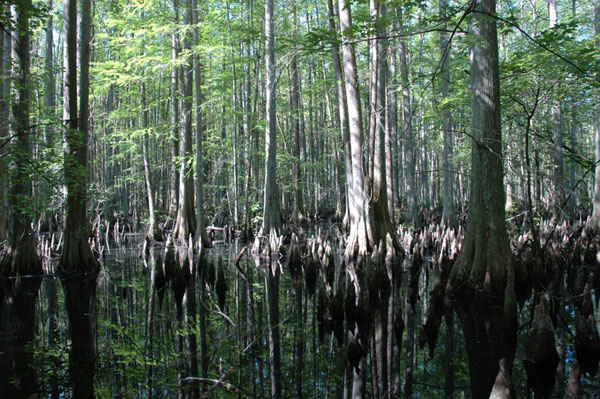Ants of Noxubee National Wildlife Refuge, Oktibbeha and Noxubee Counties, Mississippi [pdf]
Joe A. MacGown and JoVonn G. Hill
Click links to view ants in the primary habitat types at the Noxubee National Wildlife Refuge.
[Noxubee Ants-all habitats] [pine forests] [pine/hardwood forests] [bottomland hardwood forests] [upland hardwood forests] [fields, grasslands, & other open areas] [disturbed wooded areas]
A recent project was undertaken by the MEM to survey the Noxubee National Wildlife Refuge in Oktibbeha, Noxubee, and Winston Counties for ants. The refuge owns approximately 48,000 acres, which can be separated into three primary habitats: forests, fields and grasslands, and wetlands. By far, forests form the majority of the refuge and cover about 45,000 acres (about 93%). The forests can be further divided into four major types including pine (23,619 acres), mixed pine/hardwood (2,851 acres), bottomland hardwood (15,453 acres), and upland hardwood (3,263 acres). In this study we examined six terrestrial habitat types to determine species compositions for each habitat. Habitat types for this study included pine forests (both mature and young forests, and recently burned or unburned); bottomland hardwood forests (including cypress dominanted areas); upland hardwood forests; mixed pine/hardwood forests (including one area intermixed with cedar); open habitats including fields, grasslands, roadsides, and a sand pit; and disturbed, open mixed forests located near buildings and picnic areas. The latter disturbed sites were included because of their likelihood of being ideal habitats for various exotic species. In addition to the ants collected during this survey, the total list of species from the refuge includes earlier records of ants collected by the Mississippi Entomological Museum (MEM). Collecting methods included baiting, beating and sweeping vegetation, litter sampling, and visually searching for ants and their colonies. Our collections have revealed a diverse fauna, and we have collected 98 species (species list) at the refuge. A report giving the results of our study of ants at the refuge is available in pdf format [pdf].

Cypress trees at Pete's Slough
List of Ant Species from Noxubee National Wildlife Refuge
(Species are arranged alphabetically by genus)
Aphaenogaster carolinensis Wheeler
Aphaenogaster fulva Roger
Aphaenogaster lamellidens Mayr
Aphaenogaster mariae Forel
Aphaenogaster treatae Forel
Brachymyrmex depilis Emery
Brachymyrmex patagonicus Mayr (introduced, pest)
Brachymyrmex sp.-03 ?? (apparently different from B. depilis)
Camponotus americanus Mayr (pest)
Camponotus caryae (Fitch) (pest?)
Camponotus castaneus (Latreille) (pest)
Camponotus chromaiodes Bolton (pest)
Camponotus decipiens Emery (pest)
Camponotus discolor (Buckley) (pest)
Camponotus nearcticus Emery
Camponotus pennsylvanicus (DeGeer) (pest)
Camponotus snellingi Bolton (pest)
Camponotus subbarbatus Emery (pest)
Colobopsis impressa Roger
Colobopsis mississippiensis (Smith)
Colobopsis obliqua (Smith)
Crematogaster ashmeadi Mayr (pest)
Crematogaster lineolata (Say) (pest)
Crematogaster minutissima Mayr
Crematogaster pilosa Emery (pest)
Crematogaster vermiculata Emery
Cryptopone gilva (Roger)
Cyphomyrmex rimosus (Spinola) (introduced)
Discothyrea testacea Roger
Dorymyrmex bureni (Trager)
Forelius mccooki (McCook)
Formica biophilica Trager
Formica dolosa Buren
Formica pallidefulva Latreille
Hypoponera inexorata (Wheeler)
Hypoponera opaciceps (Mayr) (introduced)
Hypoponera opacior (Forel)
Linepithema humile (Mayr) (introduced, pest)
Lasius aphidicola (Walsh)
Lasius americanus Emery
Monomorium minimum (Buckley) (pest)
Myrmica pinetorum Wheeler
Myrmica punctiventris Roger
Nylanderia arenivaga (Wheeler)
Nylanderia faisonensis (Forel)
Nylanderia parvula (Mayr)
Nylanderia vividula (Nylander) (introduced?, pest)
Nylanderia trageri Kallal and LaPolla
Pheidole bicarinata Mayr (pest?)
Pheidole (crassicornis group) sp.-01
Pheidole dentata Mayr (pest?)
Pheidole dentigula Smith
Pheidole metallescens Emery
Pheidole tysoni Forel
Prenolepis imparis (Say)
Ponera exotica Smith
Ponera pennsylvanica Buckley
Proceratium crassicorne Emery
Proceratium croceum (Roger)
Proceratium pergandei (Emery)
Proceratium silaceum Roger
Pseudomyrmex ejectus (Smith) (pest?)
Pseudomyrmex pallidus (Smith) (pest?)
Solenopsis abdita Thompson
Solenopsis carolinensis Forel ? [appears to be this species]
Solenopsis invicta x richteri (introduced, pest)
Solenopsis picta Emery
Solenopsis tennesseensis M.R.Smith
Stenamma impar Forel
Stigmatomma pallipes (Haldeman)
Strumigenys abdita Wesson & Wesson
Strumigenys angulata Smith
Strumigenys clypeata Roger
Strumigenys creightoni Smith
Strumigenys dietrichi Smith
Strumigenys hyalina (Bolton)
Strumigenys laevinasis Smith
Strumigenys louisianae Roger
Strumigenys membranifera Emery (introduced)
Strumigenys metazytes (Bolton)
Strumigenys missouriensis Smith
Strumigenys ohioensis Kennedy & Schramm
Strumigenys ornata Mayr
Strumigenys pergandei Emery
Strumigenys pilinasis Forel
Strumigenys pulchella Emery
Strumigenys reflexa Wesson & Wesson
Strumigenys rostrata Emery
Strumigenys silvestrii Emery (introduced)
Strumigenys talpa Weber
Tapinoma sessile (Say) (pest)
Trachymyrmex septentrionalis (McCook)
Temnothorax americanus (Emery)
Temnothorax curvispinosus (Mayr)
Temnothorax longispinosus (Roger)
Temnothorax pergandei (Emery)
Temnothorax schaumii (Roger)
Myrmecina americana Emery
Links
MacGown, J. A., J. G. Hill, T. L. Schiefer, and R. L. Brown. 2012. Ant diversity and habitat associations at the Noxubee National Wildlife Refuge in Mississippi. Mississippi Agricultural and Forestry Experiment Station Technical Bulletin 1197. [pdf]
Landmarks article about the Noxubee Study [pdf]
Noxubee National Wildlife Refuge [http://www.fws.gov/noxubee/]


